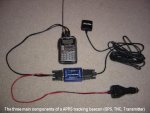Robin Lovelock
Senior Member
Hi Folks. I expect this thread will be a lot shorter than my old one for the robot boat work - still active. That's http://www.picaxeforum.co.uk/showthread.php?t=13039
This is for something almost completely different - I'm thinking of using a PICAXE as a low power electronic timer, for some GPS Bottles I'm putting together for the BBC. Background is on www.gpss.co.uk/bottle.htm
In brief, several GPS bottles will be thrown into the sea off the south coast of UK in early July, and will be tracked on a web site. This is similar to what we did several years ago (that bottle page above) but with more recent GPS tracker products, and hopefully a lower cost and simpler design.
Each glass bottle will include a GPS tracker that consumes about 50mA current (fluctuates between 40mA and 60mA max) from a NiMHd battery pack, probably of about 12v. The battery is trickle charged from a small solar panel, all inside the bottle. The solar panel will only provide 100mA to 200mA when the sun is bright, so the average power consumed needs to be a lot less than the trackers 50mA if the bottle is to continue working for many weeks, months, or indefinitely.
I'm thinking of putting a timer switch between battery and GPS tracker, as we did years ago, but this time based on a PICAXE board. The software should be pretty simple, since I did similar things before for the robot boat, but I'm wondering if I can get away with switching the 50mA (60mA max) directly from a PICAXE pin, instead of adding a transistor or chip.
Also, I'll need to check what maximum voltage I can put into the PICAXE, or add stuff to give it the required voltage from my 12v battery.
Some of this will be in your documentation, which I'll go through soon, but I'm guessing you may have some good ideas to reduce my work here. Aim is to have the simplest possible electronic switch, that can switch on the GPS tracker for perhaps 2 minutes every 20 minutes, thereby drastically reducing the average power consumed and allowing small solar panels and batteries inside the bottle.
Best Wishes to all
Robin
www.gpss.co.uk
This is for something almost completely different - I'm thinking of using a PICAXE as a low power electronic timer, for some GPS Bottles I'm putting together for the BBC. Background is on www.gpss.co.uk/bottle.htm
In brief, several GPS bottles will be thrown into the sea off the south coast of UK in early July, and will be tracked on a web site. This is similar to what we did several years ago (that bottle page above) but with more recent GPS tracker products, and hopefully a lower cost and simpler design.
Each glass bottle will include a GPS tracker that consumes about 50mA current (fluctuates between 40mA and 60mA max) from a NiMHd battery pack, probably of about 12v. The battery is trickle charged from a small solar panel, all inside the bottle. The solar panel will only provide 100mA to 200mA when the sun is bright, so the average power consumed needs to be a lot less than the trackers 50mA if the bottle is to continue working for many weeks, months, or indefinitely.
I'm thinking of putting a timer switch between battery and GPS tracker, as we did years ago, but this time based on a PICAXE board. The software should be pretty simple, since I did similar things before for the robot boat, but I'm wondering if I can get away with switching the 50mA (60mA max) directly from a PICAXE pin, instead of adding a transistor or chip.
Also, I'll need to check what maximum voltage I can put into the PICAXE, or add stuff to give it the required voltage from my 12v battery.
Some of this will be in your documentation, which I'll go through soon, but I'm guessing you may have some good ideas to reduce my work here. Aim is to have the simplest possible electronic switch, that can switch on the GPS tracker for perhaps 2 minutes every 20 minutes, thereby drastically reducing the average power consumed and allowing small solar panels and batteries inside the bottle.
Best Wishes to all
Robin
www.gpss.co.uk


